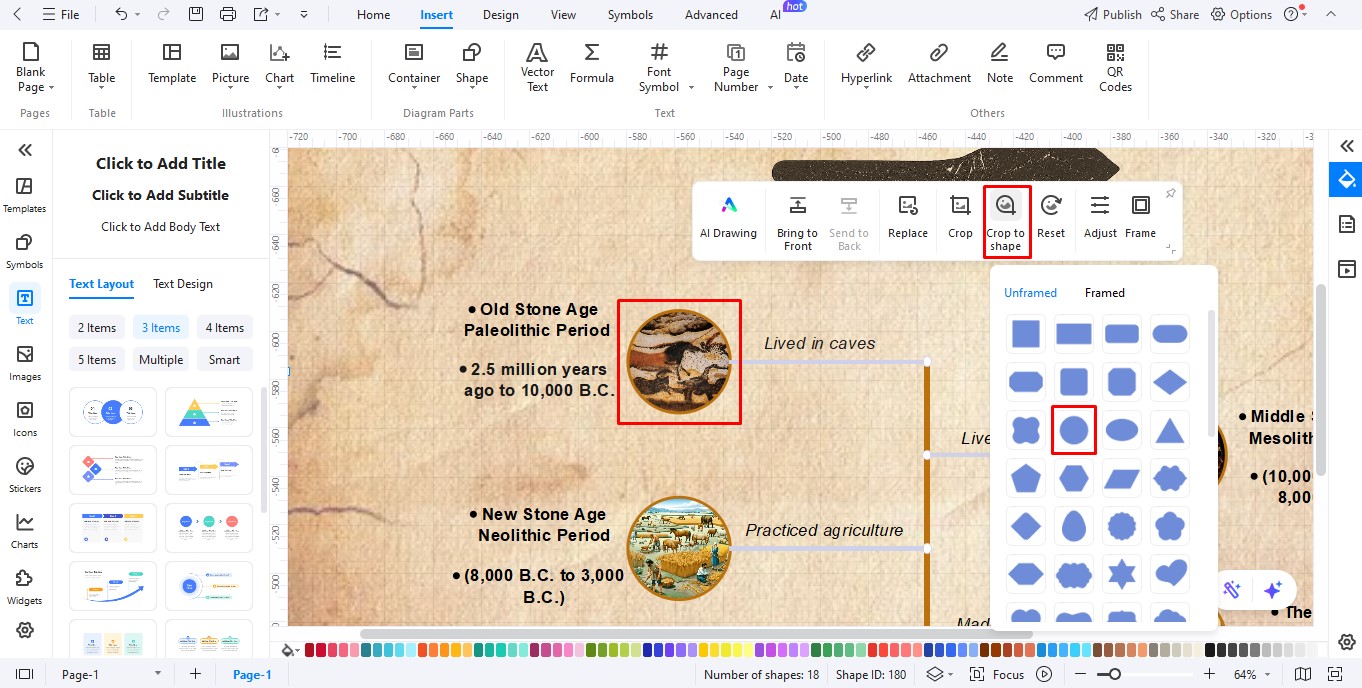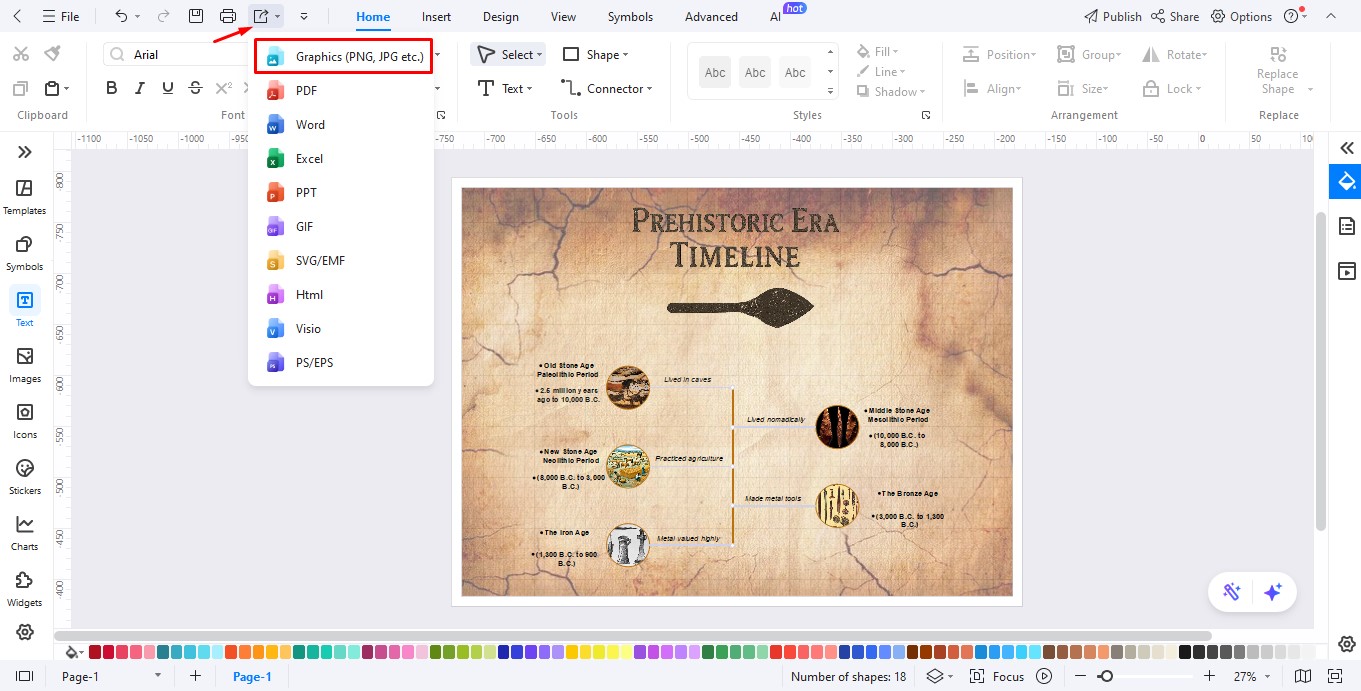Can you imagine life without cell phones, navigation apps, or cloud storage? Probably not. That’s because most of us have forgotten the lessons of human evolution. Technology has reshaped our world to the point where we feel dependent on it for everything. But there was a time when these tools didn’t exist. Yet, humans not only survived but flourished. Why? Because they were determined to move forward and build a better life.
Let’s trace the journey from primitive tools to towering castles. Let it remind us of what’s possible without gadgets or modern tech. Sometimes, grit and the will to work hard are all you need.
In this article
Exploring the Prehistoric Ages Timeline
The prehistoric timeline consists of three main eras: the Stone Age, the Bronze Age, and the Iron Age. But since the Stone Age lasted for almost 3.4 million years, it is further split into three periods. They are known as the Paleolithic, Mesolithic, and Neolithic periods.
Each of these eras is marked by significant advancements. And while we know about human evolution through the physical evidence they’ve left behind. Scientists continue to discover more amazing facts about early humans.
Here’s a quick summary of how early humans lived through the prehistoric era timeline.
Old Stone Age- Paleolithic period (2.5 million years ago to 10,000 B.C.)
In the Paleolithic period, humans lived with now extinct species like Neanderthals and Denisovans. Our earliest ancestors were mostly hunters and gatherers. They lived in caves or other temporary natural shelters.
Life revolved around basic survival. So they crafted simple tools for hunting and mastered the use of fire. Their lifestyle was very primitive. But they were resourceful enough to leave behind clues in the form of etched signs and carved figurines. The Lascaux caves in France and the Altamira caves in Spain are breathtaking examples of their artistic skill.
As the Ice Age drew to a close, so did the Paleolithic era. Dramatic climate shifts reshaped coastlines. As temperatures rose and glaciers melted, icy landscapes were transformed into lush forests. But this also meant the extinction of many Ice Age animals, including saber-toothed cats and mammoths.
Middle Stone Age-Mesolithic period (10,000 B.C. to 8,000 B.C.)
As the Ice Age ended, temperatures warmed. This allowed early humans to build more permanent shelters instead of migrating year-round. Fertile land made agriculture and animal domestication possible. It was the first step towards a settled lifestyle.
During the Mesolithic period, humans developed smaller, sharper stone tools. They shaped pointed tips and attached them to bone or wood, creating effective hunting weapons. This era acted as the bridge between the nomadic and the farming-focused humans.
New Stone Age-Neolithic Period (8,000 B.C. to 3,000 B.C.)
The Neolithic period, also known as the New Stone Age, marked a massive turning point in human history. Agriculture, food production, and construction advanced rapidly, transforming daily life. No longer just hunter-gatherers or semi-nomadic, humans began settling permanently in thriving communities.
They cultivated crops like wheat, rice, and barley. They also domesticated animals for both personal use and trade. Temporary shelters evolved into villages and towns. And with this stability came innovation. People crafted more sophisticated tools, developed new building techniques, and refined their sewing and weaving skills.
The Bronze Age (3,000 B.C. to 1,300 B.C.)
During the Bronze Age, humans learned to work with metals such as bronze, an alloy of copper and tin. Because bronze was more durable than stone, it quickly replaced stone in weapons, armor, and farming tools. Agriculture became easier with sharper blades and stronger plows.
However, bronze weaponry also transformed warfare, leading to larger and more organized battles. People became divided by geography and religion, and conflicts were settled on the battlefield. With organized governments and defined social classes, the nomadic way of life became history.
Trade networks expanded, and large-scale construction projects became common. Many of the world’s earliest writing systems emerged during this era. For example, hieroglyphics in Egypt and cuneiform in Mesopotamia.
Despite these advancements, the Bronze Age ended around 1200 BCE in many regions due to a mysterious collapse. Territorial invasions and widespread societal disruptions made way for the Iron Age.
The Iron Age (1,300 B.C. to 900 B.C.)
The Iron Age was the period when humans moved beyond bronze and mastered the use of iron. They developed techniques to heat and forge the metal, using it in tools, weapons, and construction.
This era saw major advancements. Humans built canal systems and improved transportation by making sturdier ships. Agriculture became more efficient with stronger iron tools. And people began traveling greater distances for trade, as well as to exchange knowledge, culture, and technology.
The Iron Age also marked the rise of powerful empires such as Assyria, Greece, and Rome. Rulers built towering fortresses protected by large, well-equipped armies. By the end of this period, sophisticated writing systems had emerged.
How to Make a Timeline using EdrawMax?
Do you want to create a timeline like the one above? Try EdrawMax. This powerful diagramming tool removes the guesswork from designing timelines, making it easy to create custom visuals with precision. You can start from scratch or save time by customizing one of the many prebuilt templates. Either way, you’ll end up with a professional-looking timeline that’s entirely your own.
Simply download EdrawMax and follow the steps below to create a custom design.
Step1 Start With a Blank Canvas
- Open EdrawMax on your desktop.
- Locate New on the left panel. Click to reveal options.
- Select Blank Drawing to open a new canvas.

Step2 Add Background Image
- Click Insert on the top toolbar and select Picture from the options.
- Choose Local pictures to upload a background image to the timeline. If you click on the image, an editing panel will appear, allowing you to adjust the image’s brightness, contrast, and transparency.

Step3 Insert Image As Heading
- The next step is to add a title to your timeline. Let’s use another image as the heading.
- Follow the same steps outlined above: Insert > Picture > Local Pictures to insert an image.
- You can also add more images around the title to make it stand out.

Step4 Insert Timeline
- Click Insert for more options.
- Select Timeline and scroll down to Vertical Timeline.
- Choose the 4th vertical timeline option that includes images.

Step5 Add Text to the Timeline
- Locate and select Text on the left editing panel.
- Choose Click to Add Subtitle and insert the first era’s name and duration.
- Select Click to Add Body to enter a highlight of that era.
- Continue adding the remaining prehistoric eras and their details to the timeline.

Step6 Add Thumbnail Images
- Follow Insert > Picture > Local pictures to add thumbnails to each prehistoric era.
- You can change the image’s outline as well. Select the image to reveal cropping options and select the shape you prefer.
- Add thumbnails to all the prehistoric eras to complete the timeline.

Step7 Export Image
- You can export the image once the timeline is ready.
- Click Export on the top panel to view your saving options.
- With EdrawMax, you can export the timeline in multiple formats, including JPG, PDF, Word, Visio, GIF, etc.
- Select Graphics if you want to save the file in JPG, PNG, BMP, or TIFF format.
- Choose the desired option and click Export.

Final Word
The prehistoric era timeline is a powerful reminder of our determination to survive. Compared to dinosaurs, which ruled the planet for 165 million years, our mere 3 million years may seem insignificant. Yet in that short span, humans have unlocked countless mysteries of our planet.
If you enjoy exploring the story of evolution, try creating your own timeline with EdrawMax. Its intuitive design tools make it easy to craft professional-looking diagrams in no time.





